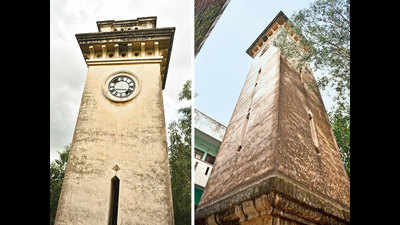- News
- City News
- Hyderabad News
- Remembering the forgotten heroes who fought to free Hyderabad from the Nizam
Trending
This story is from September 17, 2017
Remembering the forgotten heroes who fought to free Hyderabad from the Nizam

September 17 is a red letter day in Hyderabad’s history. It’s on this day in 1948 that Operation Polo ended, with the Nizam surrendering to the Indian army. led by Major General JN Chaudhari under Sardar Patel’s instructions, the army marched into Hyderabad, marking the end of Nizam’s rule, paving the way for formal annexation of the princely state of Hyderabad into the Indian Union.But even before the army swung into action, a brave trio of freedom fighters — Narayan Rao Pawar, Jagdeesh Arya and Gandaiah Arya — had decided to take on the might of the Nizam all by themselves.
Armed with nothing more than hand grenades, the trio set out on a daring mission to assasinate Mir Osman Ali Khan, the last Nizam, on December 4, 1947. They may have been forgotten today, but Narayan Rao Pawar and his aides used to be hailed as dare-devil freedom fighters of Telangana during those days, says Dr Uma Joseph, historian and dean of academics at St Francis College for Women, Begumpet.
“Pawar was the one who hurled the hand grenade at the Nizam’s car, while he was travelling from King Koti palace to Mecca Masjid that eventful day. A practising advocate at the Hyderabad high court at the time of the attack, Pawar drew inspiration from Netaji Subhash Chandra Bose,” says Uma.
A DARING ASSASINATION BID THAT ALMOST KILLED THE NIZAM
The grenade touched the door of the car, which was heavily damaged, but the Nizam escaped unhurt. “Pawar was arrested along with Jagdeesh and Gandaiah immediately, while the Nizam was escorted back to the safety of the palace. Pawar was sentenced to death for waging war against the ruler, while the others were awarded life imprisonment,” added Uma. Later, Pawar would recount tales of being beaten up brutally by the police in jail and being forced to drink urine. But after Hyderabad’s surrender, Pawar’s sentence was reduced to life imprisonment by General Chaudhari. And later, on August 10, 1949, he was set free unconditionally, along with others, under the orders of Indian government.
Historian Narendra Luther recounts that the attack on Nizam was a reaction by the youth against his policies. “It was an expression of the discontentment harboured by the citizens against the ruler. The trio risked their lives to liberate the state from the Nizam’s rule, but later, they simply faded into oblivion. Their act was viewed as criminal by the administration. But even after Nizam’s Hyderabad fell, neither did they get their due in history books nor did they figure prominently in works of scholars. they were completely forgotten.”
Armed with nothing more than hand grenades, the trio set out on a daring mission to assasinate Mir Osman Ali Khan, the last Nizam, on December 4, 1947. They may have been forgotten today, but Narayan Rao Pawar and his aides used to be hailed as dare-devil freedom fighters of Telangana during those days, says Dr Uma Joseph, historian and dean of academics at St Francis College for Women, Begumpet.
“Pawar was the one who hurled the hand grenade at the Nizam’s car, while he was travelling from King Koti palace to Mecca Masjid that eventful day. A practising advocate at the Hyderabad high court at the time of the attack, Pawar drew inspiration from Netaji Subhash Chandra Bose,” says Uma.
A DARING ASSASINATION BID THAT ALMOST KILLED THE NIZAM
“Narayan Rao, Jagdeesh Arya and Gandaiah Arya were armed with four bombs and carried a poison box with them so that the could take their lives after killing the Nizam. Pawar was positioned at the All Saints Lane, while Gandaiah was at Bogukunda and Jagdish stood nearby waiting for Nizam’s motorcade to arrive. As Nizam’s car approached, Pawar rushed towards it and hurled the grenade at Nizam after pushing a constable,” says Uma, retelling the eventful incidents of that fateful day.
The grenade touched the door of the car, which was heavily damaged, but the Nizam escaped unhurt. “Pawar was arrested along with Jagdeesh and Gandaiah immediately, while the Nizam was escorted back to the safety of the palace. Pawar was sentenced to death for waging war against the ruler, while the others were awarded life imprisonment,” added Uma. Later, Pawar would recount tales of being beaten up brutally by the police in jail and being forced to drink urine. But after Hyderabad’s surrender, Pawar’s sentence was reduced to life imprisonment by General Chaudhari. And later, on August 10, 1949, he was set free unconditionally, along with others, under the orders of Indian government.
Historian Narendra Luther recounts that the attack on Nizam was a reaction by the youth against his policies. “It was an expression of the discontentment harboured by the citizens against the ruler. The trio risked their lives to liberate the state from the Nizam’s rule, but later, they simply faded into oblivion. Their act was viewed as criminal by the administration. But even after Nizam’s Hyderabad fell, neither did they get their due in history books nor did they figure prominently in works of scholars. they were completely forgotten.”
End of Article
FOLLOW US ON SOCIAL MEDIA










